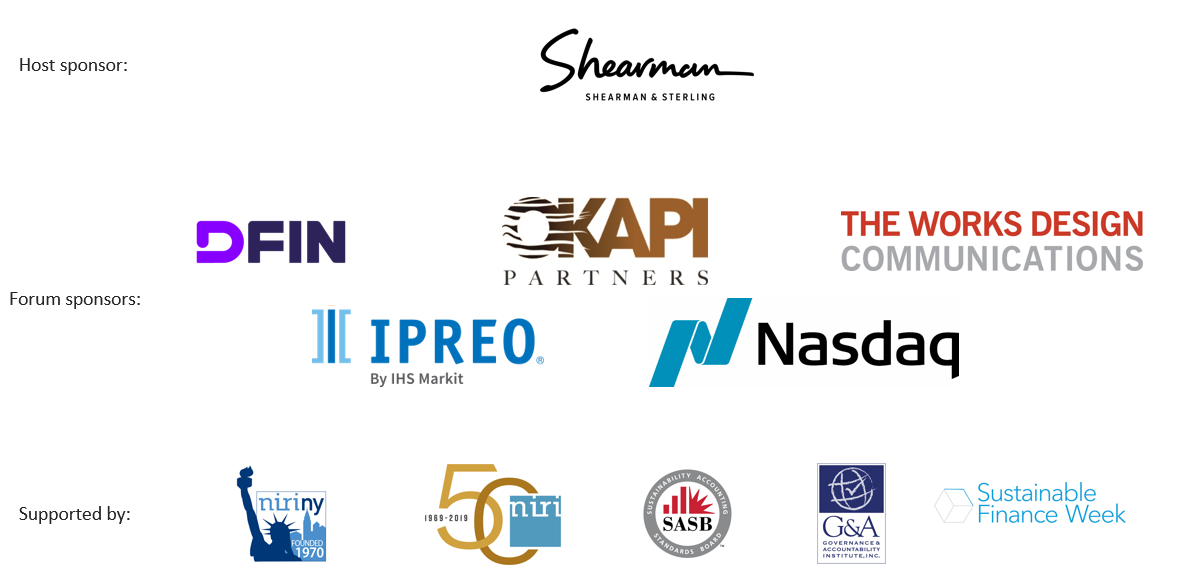ESG is on the minds of investors – both active and passive – and it’s incumbent on IR teams, corporate secretaries and other in-house counsel to work together to identify and report on material risks and opportunities, according to leading experts.
More than 130 people gathered in New York last month for the inaugural ESG Integration Forum. This was the first time the IR Magazine and Corporate Secretary audiences had come together under one roof in acknowledgement that ESG is an issue driving the need to collaborate.
The event was part of Sustainable Finance Week in New York, which included Bloomberg’s Global Responsible Investing Forum, the Sustainability Accounting Standards Board’s (SASB) annual symposium and the RI Americas annual conference. In total, more than 1,200 issuers, investors, regulators and academics participated in the dialogue during the week.
The message was clear: investors are considering material ESG issues and are calling for better-quality corporate reporting.
Active and passive managers back ESG
‘I think investing without considering material ESG issues is breaking the fiduciary duty investors have – anyone who is doing that should be out of a job or in jail,’ said Erika Karp, chief executive officer at Cornerstone Capital, in what was a lively start to the ESG Integration Forum.
Cornerstone Capital is an investment advisory and wealth management firm that has grown significantly since its launch in 2013. Karp explained how ESG is central to the investment decisions the firm makes: ‘There’s no such thing as ESG investing, there’s only ESG analysis. That’s the systematic integration of ESG analysis into any investment decision.’
She also emphasized that as CEO of the firm, she needed to ensure the company and its employees walked the walk of ESG – meaning she had a keen focus on the internal culture at the firm.
Michael Stiller, global co-head of strategic capital intelligence at Nasdaq, spent several years working in hedge funds and said their historic approach to ESG has been to dismiss it. ‘If you asked hedge funds 10 years ago whether they included ESG, they’d laugh at you,’ he said.
He explained, however, that hedge funds have recognized ESG as an important matter to index investors that could be a useful way to build relationships and support for potential activist campaigns. ‘What activists have realized is that they need support to run a proxy campaign and if the index community cares about specific ESG topics, it behooves the activist community to include those topics as part of their campaign,’ Stiller said.
Jana Partners has perhaps achieved the most headlines for working with a pension fund – CalSTRS – on its shareholder proposal at Apple last year, but Stiller explained that this kind of collaboration will become more prevalent and widespread.
Inconsistent ESG reporting
John Truzzolino, director of business development at Donnelley Financial Solutions, explained that there have been a lot of good faith attempts by issuers to improve their ESG reporting or incorporate it into existing reports, but that – despite best efforts – it hasn’t been what investors are looking for.
‘Fortune 500 companies’ efforts to disclose [ESG data] has been significant in the last five years, but they’re disclosing it in different ways,’ Truzzolino explained. ‘Sometimes [the data] appears in the 10Q, sometimes in the proxy statement or the sustainability report. Some companies are putting ESG information on their websites for the first time. But it isn’t standard, which makes it hard for investors to consume it.’
While there are many different reporting frameworks available to issuers to consider, the one that received the most endorsement was the SASB framework. SASB launched its finalized industry-specific standards late last year, following several years of input from a large investor support group.
But even with such standards now available in a format that investors say they want, there was concern in the room about how resource-intensive it would be to produce a new ESG materiality report. For instance, Truzzolino and Stiller both acknowledged that small and mid-cap companies are much less likely to have begun their ESG reporting journey, given that they have smaller budgets and fewer resources.
Stephen Giove, partner at forum host sponsor Shearman & Sterling, said he encouraged his clients to begin reporting and build a plan for how to add to it in the future. ‘We tell our clients to look at where they are and then come up with a three-year plan,’ he said. ‘Pick the most important topics and start there. You can then build on it over a longer time period.’
One audience member expressed concerns about reporting on ESG topics because the quality of the data is far less assured than it is in the realm of financial reporting. Giove acknowledged that this is a widely held concern. ‘Given how tight Sarbanes-Oxley is, clients feel highly confident when they report on financial metrics that they are accurate,’ he said.
‘Then in the ESG world you have people feeling uncomfortable about the ESG data, compared with the more concrete data points. We suggest putting it out in the 10Q along with some wording to the effect that it’s less concrete. If you wait until you increase your comfort level from a three to a 10, you’ll wait for years.’
The need for internal buy-in and collaboration
One of the reasons for hosting the ESG Integration Forum and bringing together IROs, corporate secretaries and sustainability professionals was that the journalists at IR Magazine and Corporate Secretary often hear differing approaches and attitudes toward ESG. They have interviewed IROs and in-house legal professionals at the same company who have very different approaches and accounts of whether their investors are concerned about ESG.
So if the goal of the event was to reach across the aisle and foster greater collaboration, Yafit Cohn, associate group general counsel at The Travelers Companies, proved to be a great role model. Cohn was hired by the firm’s chief legal officer with the mandate of getting to grips with which ESG issues the company’s investors care about.
She partnered with the IR team and met with around 50 percent of the company’s total shareholder base in the first three months of 2018. Cohn said it was a job that involved her and the IR team being dogged in their follow-ups. ‘My approach was that we were looking to enhance our ESG disclosures and were looking for input from our partners and investors,’ she explained ‘Taking that approach was really fruitful. I definitely still had to follow up repeatedly with some people, but that’s how I got to 50 percent of the investor base.’
Cohn said she has a much clearer sense of what issues Travelers’ investors deem to be either material or otherwise salient to the company and how they would like to see them reported on. She has presented her findings to senior management, and those findings have served as the foundation for her recommendations as to how the company should enhance its ESG reporting.
As a broader example, Giove recommended that ESG stakeholders get together at the start of the year to plan ahead. ‘I suggest getting your calendars out – the IR calendar, the legal calendar, the sustainability calendar. Look for the issues that cross all three groups and see what opportunities there are for collaboration throughout the year. Whether it’s the 10K, the proxy statement or something else, there are plenty of opportunities for collaboration.’











